Scotland's Carers
This report brings together statistical analysis and research on caring. The report is intended to provide a useful source of information for carer's organisations, policy makers, local authorities and anyone who is a carer or knows someone who is a carer.
3. Chapter 3: Carers' Employment, Health and Finance
- 56% of all carers are employed or self-employed; 25% of carers are retired
- 35% of carers who care for 35 or more hours a week are employed or self-employed; 34% are retired
- 79% of women and 75% of men said that caring had not affected their employment
- 7% of women and 5% of men said they were unable to take up work because of caring responsibilities
3.1. Introduction
In this section we consider the survey findings on carers' employment status and their health.
We know from research that many working age carers are in employment, primarily as an economic necessity (Yeandle, et al., 2007b). Economically, carers continuing in employment can be important for their current income and their longer term finances due to the impact on pension contributions of stopping work. As expected there is an inverse relationship between caring and employment and one can impact on the other, for example those providing fewer hours care are more likely to be in employment, in some cases because work is used as a way to resist being drawn into more time on caring (King & Pickard, 2013).
Many carers leave employment to meet the demands from caring. It is recognised that employment falls when caring is for over 20 hours per week (Carmichael, et al., 2010) and recent research indicates that this is case when carers aged 50 plus provide 10 hours plus care (King & Pickard, 2013). This is not distributed evenly and socio-economic factors play a role i.e. less well-educated, older carers and those in poorer health are at increased likelihood of exiting the labour market (King & Pickard, 2013). It should also be noted that carers themselves can have health problems that affect their ability to sustain employment (Yeandle, et al., 2007a).
Whilst paid work can be important it is not a guarantee of freedom from financial difficulties. One third of carers in employment in a recent study reported they are struggling financially (Yeandle, et al., 2007b). People providing the most intensive care (20 hours and more) are more likely to be in lower level occupations (King & Pickard, 2013).
3.2. Economic status of carers
Scotland's 2011 census shows that overall 11% of people aged 16 and over are carers (over 482,000 people in Scotland).
- 56% of these carers are employed or self-employed;
- 25% are retired;
- 8% are looking after home or family;
- 5% are long-term sick or disabled themselves; and
- 7% are doing other things, most of which are students or unemployed.
Figure 32: Employment status of carers (482,000 people aged 16+), 2011
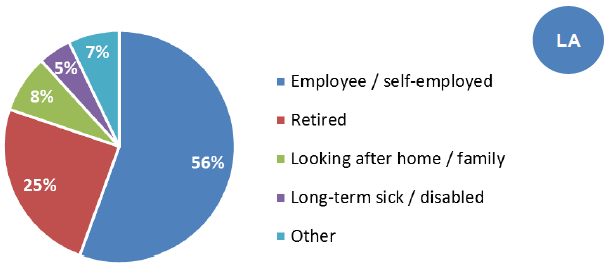
Source: Scotland's Census 2011
Scotland's 2011 census shows that nearly 4% of the population (over 171,000 people) provide 35 hours or more a week of care, equivalent to working full-time.
- Over a third of these "full-time" carers (who care for 35 hours or more a week) are also employed or self-employed;
- A third are retired;
- 16% look after home and family;
- 8% have themselves a long-term illness or disability; and
- 7% are students, unemployed, or doing other things.
Figure 33: Employment situation of 171,000 people who provide 35 hours or more care each week, 2011
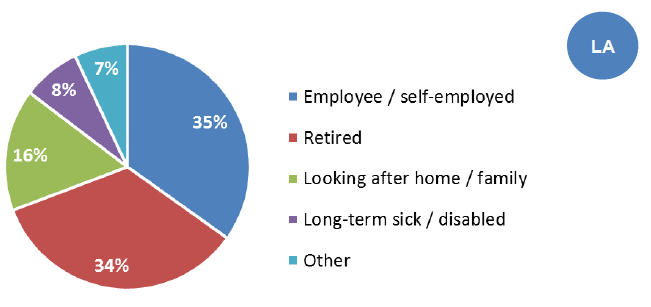
Source: Scotland's Census 2011
Perhaps not surprisingly, people who said they are looking after home and family in Scotland's 2011 Census are the most likely to be a carer: Over 27% are carers and over 19% care for 35 hours or more a week. Retired people are also more likely to provide care: Over 12% are carers and 6% provide 35 hours or more each week. Students are the least likely to be carers: only 4% of students are carers, similar to the child rate of caring and less than 1% care for 35 or more hours per week.
Figure 34: Proportion of working age population who provide care, by employment status
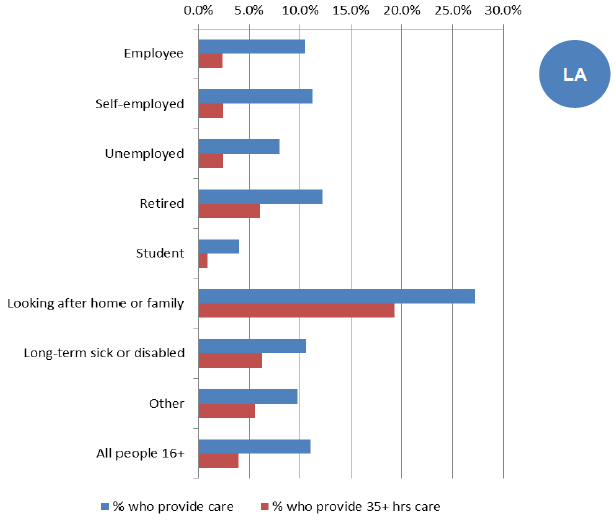
Source: Scotland's Census 2011
3.3. Caring impact on employment
SHeS asks people whether caring has had any impact on their employment. Overall 79% of women and 75% of men said that caring had not affected their employment. Over 65s and 16-24 year olds were most likely to say that caring had not impacted on employment so this may be because they had retired from work or because they had never had a job.
Figure 35: Percentage of people aged 16+ who said that caring had an impact on their employment, 2012/2013
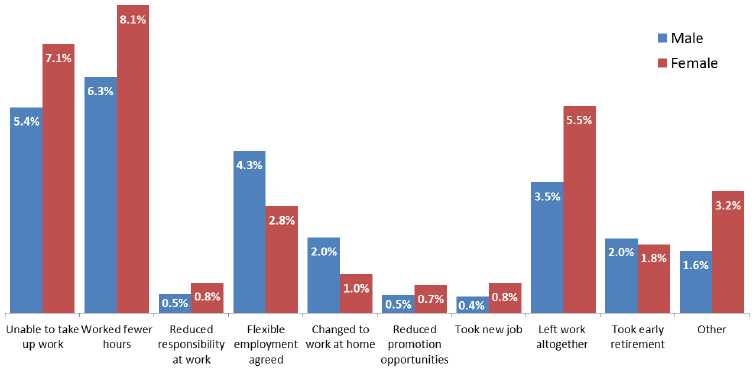
Source: Scottish Health Survey 2012/2013
Where people did say that it had had an impact on their employment, in most cases a larger proportion of women rather than men were affected. This in part explains the higher proportion of women carers of working age not in employment.
- 7% of women and 5% of men said they were unable to take up work because of caring responsibilities
- 8% of women and 6% of men said they worked fewer hours in order to balance their caring with work commitments
- 5% of women and 3% of men said they had left work altogether because of caring responsibilities
- A small percentage (less than 1% in all cases) said that they had reduced their responsibilities at work, caring had reduced their promotion opportunities or caring had resulted in them taking a new job.
Areas where men were more likely than women to feel the impact of caring were:
- 4% of men and 3% of women agreed more flexible employment terms with their employer to enable them to continue with caring
- 2% of men and 1% of women changed to working at home because of caring commitments
- 2% of men and just under 2% of women took early retirement because of caring responsibilities.
Research indicates that carers, who want to, should be supported better to remain in employment (King & Pickard, 2013). Currently much of this support is by family and friends, although finding time to spend with them can be difficult for carers in employment (Yeandle, et al., 2007a).
Formal services can enable carers to continue working (Yeandle & Wigfield, 2011) but carers experience difficulty in obtaining the appropriate, timely services, even when skilled and helpful staff are involved (Yeandle, et al., 2007a).
How employers treat staff with caring responsibilities can make a difference. Some carers report that employers are supportive, accepting of emergency absences and planned changes in working patterns, although others have a very different experience (Yeandle, et al., 2007a).
3.4. Carers, health and employment
- Carers who are economically active report better health than those who are not
- People who care for 35 hours a week or more are least likely to say their health is 'good' or 'very good'
- People aged 65+ who care for up to 19 hours a week report by far the best health for that age group
People who are economically active (this includes people in work, self-employed, looking for work) are much more likely to say their health is "good" or "very good" than people who are economically inactive (this includes people who are retired, looking after home and family, long-term sick or disabled and students).
92% of people who are economically active and don't provide care say that they have good or very good health. This percentage reduces as people provide more care and only 82% of those who provide 50 or more hours of care say that they have "good" or "very good" health.
Figure 36: Percentage of people who say their health is very good or good, by economic status, 2011
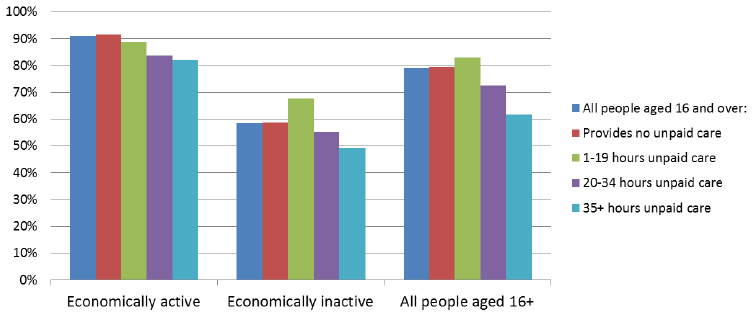
Source: Scotland's Census 2011
When looking at people who are economically inactive the picture is slightly different with those who provide up to 19 hours of care a week having the best health - 68% say their health is "good" or "very good".
Looking at chart 37, it is clear that this is true mainly for retired people who provide care. Interestingly people who are long term sick or disabled seem to show improving health, the more hours that they care each week. Overall only 17% of people in this category say that their health is "good" or "very good" but this increases to 20% of people who provide 20-34 hours of care and 19% of people who provide 35 hours of care or more.
Figure 37: Percentage of people who say their health is very good or good, by employment status, 2011
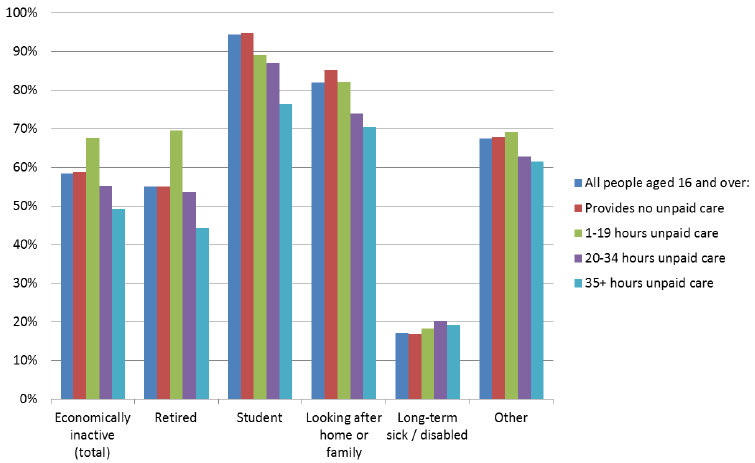
Source: Scotland's Census 2011
3.5. Carer's allowance
- Nearly 172,600 people in the 2011 Census said they provided 35 or more hours of care, the threshold for carer's allowance
- In 2014, around 104,000 people were entitled to carer's allowance, but just over half of these people received it
- In 2014, around 59,000 people received carer's allowance
Surveys of carers, which tend to involve those with more intensive caring responsibilities, highlight issues such as debt associated with caring. Carers may face additional financial burdens because of their caring responsibilities through for example higher utility bills, modifications to the home to meet the needs of the cared for person. In a recent UK survey of carers, four in ten carers indicated that they had been in debt as a result of caring and five in ten felt that financial worries were affecting their health (Carers UK, 2013).
Carers who are aged 16 or over and spend at least 35 hours a week caring for someone with substantial caring needs can claim carer's allowance depending on their level of earnings. Carer's allowance is taxable and can also be affected by other benefits such as Universal Credit and Pension Credit.
Scotland's 2011 Census shows that nearly 172,600 people provided 35 or more hours of care each week which is the threshold for carer's allowance. Department for Work and Pensions (DWP) statistics show that in 2014, around 104,000 of the people who applied for carer's allowance were entitled to it and around 59,000 people actually received carer's allowance.
Figure 38: People entitled to, and receiving, Carer's Allowance, 2003-2014
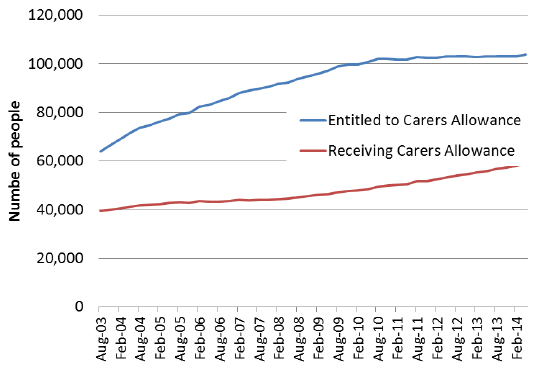
Source: Department for Work and Pensions (2003-2014)
The number of people entitled to carer's allowance in Scotland increased steadily between 2003 and 2010 but has remained fairly level since then at just over 100,000 people.
The number of people receiving carer's allowance has been rising steadily since 2003 to 59,000 people in May 2014.
Currently around 57% of people who are entitled to carer's allowance actually receive it. People may not receive carer's allowance because they are already receiving other benefits such as pension credit. Over 65s are the most likely to not receive carer's allowance when they are entitled to it.
Figure 39: People in Scotland entitled to, and receiving, Carer's Allowance, by age, 2011
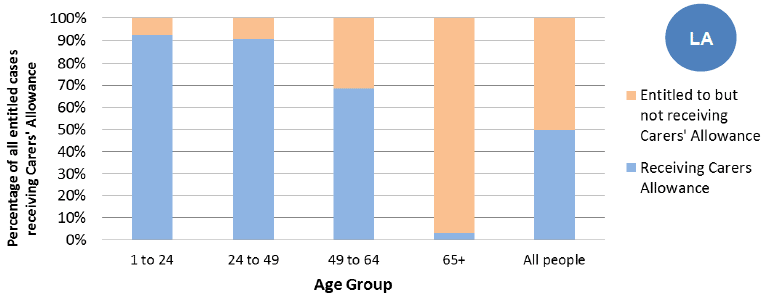
Source: Department for Work and Pensions (2011)
3.6. Conclusion
As with the wider population, more carers of working age are in paid employment. As well as ensuring a break from caring and providing a sense of fulfilment, employment offers a source of income in the short and longer term. However employment alone does not ensure adequate income and financial security. A large minority of fulltime carers are in employment, and many of those caring for over 20 hours are in lower level occupations. Caring can result in carers reducing the hours they work or leaving employment. For some this is the right move. For others timely support would have enabled them to continue in employment.
Contact
Email: Steven Gillespie
There is a problem
Thanks for your feedback
